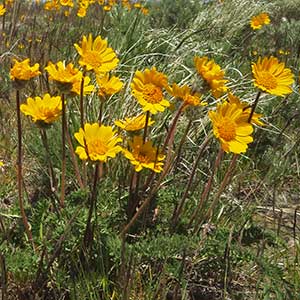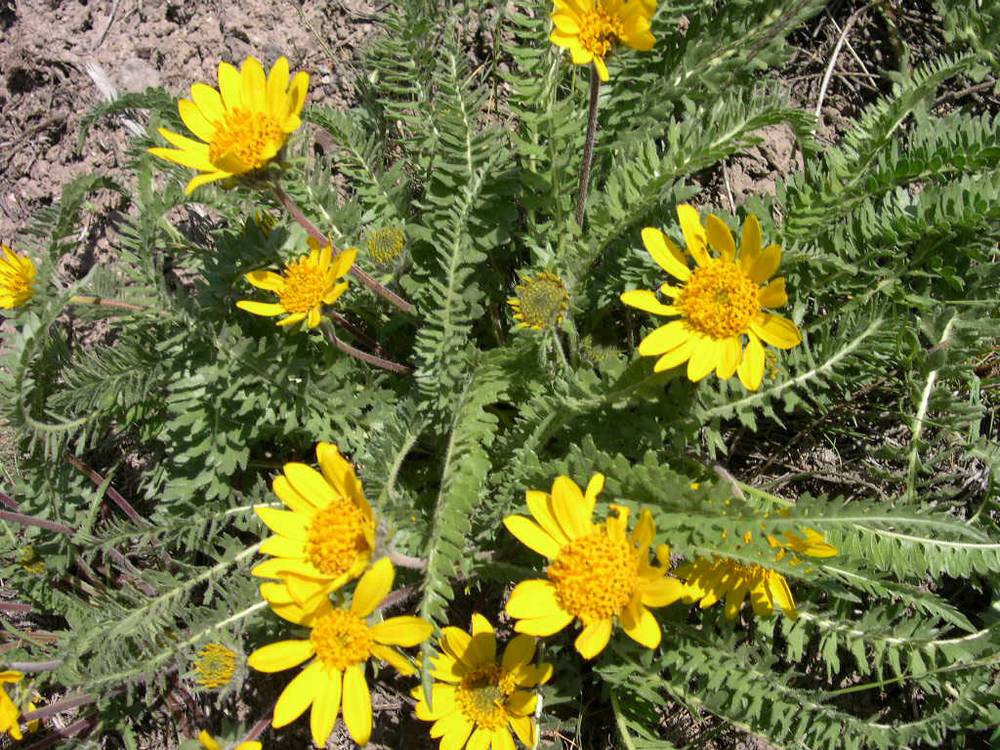Balsamorhiza hookeri
Balsamorhiza hispidula
Hooker's balsamroot
hispid balsamroot
11–47 cm; hirsute; from single taproot.
8–25 cm, villous-hirsute; from single taproot.
lanceolate to ovate-lanceolate, 1-pinnately divided with some pinnae toothed or lobed to 3-pinnately lobed;
margins entire to crenate or serrate;
surfaces hirsute to hirsute-sericeous;
basal leaves in 1–few rosettes;
blades 12–24 × 4–12 cm;
pinnae 1–10 mm wide;
petioles 4–15 cm;
cauline blades 3–14.5 × 0.6–4 cm;
petioles 4–11 cm.
ovate-lanceolate, 1-pinnately divided with pinnae again lobed, often with only a few lobes at tips or divided;
margins entire, ciliate;
surfaces hispid;
basal leaves in 1–few rosettes;
blades 5–18 × 3–7.5 cm;
pinnae 2–8 mm wide;
petioles 2–9 cm;
cauline leaves in one opposite pair;
blades 1.5–5 × 0.4–2 cm;
petioles 1.5–4 cm.
with 1 terminal head.
with 1 terminal head.
8–15 × 15–25 mm.
10–15 × 17–22 mm.
deciduous, 10–17, yellow;
rays 15–30 × 4–7 mm.
deciduous, 10–13, yellow;
rays 20–25 × 5–10 mm.
~6 mm.
6–7 mm.
linear-lanceolate to ovate, 13–20 × 3–6 mm, with or without long-acuminate tips, villous-hirsute and ciliate, sometimes glabrous proximally.
linear to lanceolate, 14–17 × 2–3 mm, with acuminate or caudate tips, ciliate, villous-hirsute.
6.5 × 1.5 mm, glabrous.
6–7 mm, glabrous.
11–12 mm.
7–8 mm.
=38.
Balsamorhiza hookeri
Balsamorhiza hispidula
Dry, open, often rocky areas. Flowering Apr–Jun. 1000–1600 m. BR, BW. CA, ID, NV, WA; southeast to UT. Native.
As treated here, B. hookeri consists of the members of section Balsamorhiza that are left over after the entities that are distinct in at least some parts of their ranges are removed. Balsamorhiza hookeri hybridizes with B. hispidula and B. sagittata. The species is named after the British botanist William Jackson Hooker, who initially described it as Heliopsis balsamorhiza and tentatively proposed (but did not validly publish, as he did not accept it) the genus Balsamorhiza under the supposition that it would prove to be distinct from Heliopsis once better material was collected.
Dry, often rocky, open areas. Flowering Apr–Jun. 800–1700 m. BR, BW, Owy. ID, NV; northeast to MT, east top WY, southeast to AZ. Native.
While B. hispidula is quite distinct from B. hookeri throughout most of its range, it intergrades completely with B. hookeri in Oregon. Although the two species have been kept separate in this treatment, most Oregon specimens of B. hispidula show some evidence of gene flow from B. hookeri. Balsamorhiza hispidula also hybridizes with B. sagittata. The specific epithet refers to the pubescence of the plants.
Abigail (Abby) Moore
Abigail (Abby) Moore





